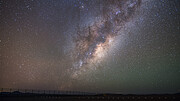New ESO’s VLT image of the NGC 2899 planetary nebula
NGC 2899 in the constellation of Vela
The sky around NGC 2899
Videos

ESOcast 227 Light: Stunning Space Butterfly Captured by ESO Telescope
Zooming in on the planetary nebula NGC 2899
Resembling a butterfly with its
symmetrical structure, beautiful colours, and intricate patterns, this
striking bubble of gas — known as NGC 2899 — appears to float and
flutter across the sky in this new picture from ESO’s Very Large
Telescope (VLT). This object has never before been imaged in such
striking detail, with even the faint outer edges of the planetary nebula
glowing over the background stars.
NGC 2899’s vast swathes of gas extend up to a maximum of
two light-years from its centre, glowing brightly in front of the stars
of the Milky Way as the gas reaches temperatures upwards of ten thousand
degrees. The high temperatures are due to the large amount of radiation
from the nebula’s parent star, which causes the hydrogen gas in the
nebula to glow in a reddish halo around the oxygen gas, in blue.
This object, located between 3000 and 6500 light-years away
in the Southern constellation of Vela (The Sails), has two central
stars, which are believed to give it its nearly symmetric appearance.
After one star reached the end of its life and cast off its outer
layers, the other star now interferes with the flow of gas, forming the
two-lobed shape seen here. Only about 10–20% of planetary nebulae [1] display this type of bipolar shape.
Astronomers were able to capture this highly detailed image
of NGC 2899 using the FORS instrument installed on UT1 (Antu), one of
the four 8.2-metre telescopes that make up ESO’s VLT in Chile. Standing
for FOcal Reducer and low dispersion Spectrograph, this high-resolution
instrument was one of the first to be installed on ESO’s VLT and is
behind numerous beautiful images and discoveries from ESO. FORS has
contributed to observations of light from a gravitational wave source, has researched the first known interstellar asteroid, and has been used to study in depth the physics behind the formation of complex planetary nebulae.
This image was created under the ESO Cosmic Gems programme,
an outreach initiative to produce images of interesting, intriguing or
visually attractive objects using ESO telescopes, for the purposes of
education and public outreach. The programme makes use of telescope time
that cannot be used for science observations. All data collected may
also be suitable for scientific purposes, and are made available to
astronomers through ESO’s science archive.
Notes
[1] Unlike what their common name suggests, planetary nebulae
have nothing to do with planets. The first astronomers to observe them
merely described them as planet-like in appearance. They are instead
formed when ancient ultraviolet radiation
energises and lights up these moving shells, causing them to shine
brightly for thousands of years until they ultimately disperse slowly
through space, making planetary nebulae relatively short-lived phenomena
on astronomical timescales.
More information
ESO is the foremost intergovernmental astronomy organisation in Europe and the world’s most productive ground-based astronomical observatory by far. It has 16 Member States: Austria, Belgium, the Czech Republic, Denmark, France, Finland, Germany, Ireland, Italy, the Netherlands, Poland, Portugal, Spain, Sweden, Switzerland and the United Kingdom, along with the host state of Chile and with Australia as a Strategic Partner. ESO carries out an ambitious programme focused on the design, construction and operation of powerful ground-based observing facilities enabling astronomers to make important scientific discoveries. ESO also plays a leading role in promoting and organising cooperation in astronomical research. ESO operates three unique world-class observing sites in Chile: La Silla, Paranal and Chajnantor. At Paranal, ESO operates the Very Large Telescope and its world-leading Very Large Telescope Interferometer as well as two survey telescopes, VISTA working in the infrared and the visible-light VLT Survey Telescope. Also at Paranal ESO will host and operate the Cherenkov Telescope Array South, the world’s largest and most sensitive gamma-ray observatory. ESO is also a major partner in two facilities on Chajnantor, APEX and ALMA, the largest astronomical project in existence. And on Cerro Armazones, close to Paranal, ESO is building the 39-metre Extremely Large Telescope, the ELT, which will become “the world’s biggest eye on the sky”.
Links
Contacts




